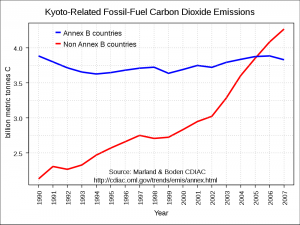Representatives from 194 countries around the world have been at COP17 in climate talks for the past week trying to get Kyoto II signed, but the US, China & India are barely even talking.
With global carbon emissions higher than ever before, the UNFCCC is pushing hard for a successor to the Kyoto Protocol, but the two fastest growing economies in the world do not seem keen to agree to legally binding targets to reduce their carbon emissions.
The current situation is that the US won’t even start to discuss anything unless China and India both agree to sign up to the same legally binding emissions targets as everyone else. India is outright refusing to agree to anything that damages its economic growth, and China is unlikely to play ball if India does not, so essentially we have a stalemate situation.
China and India were not included in Kyoto I, as they were classed as ‘developing countries’, but now the EU bloc is seeking to get India and China to both agree to legally-binding emissions reductions, along with all other ‘developing countries’.
While western economies are deep in recession, India and China’s economies have been booming.
China now has the largest carbon footprint in the world, and India’s economy is estimated to have grown by 10.4% in 2010 alone. Understandably, the Indians are seeking a similar deal as they got in Kyoto I – the richest countries in the world cut emissions while the developing nations carry on as normal.
Economic power, but still in poverty
India’s population is now an estimated 1.2 billion people – most of whom still live in severe poverty. For this reason it sees no reason to sign the treaty, as the recent increases in their carbon emissions has led to a massive decrease in the number of poor.
It’s a controversial subject, but burning fossil fuels in China and India has recently given millions of these people access to electricity for the first time ever – something we all take for granted in the west, so much that we only seem to argue about the source that generates it.
Meanwhile, Rajenda Pachauri, Chairman of the Intergovernmental Panel on Climate Change has been highlighting new IPCC research that says that the Himalayan glaciers, which supply water to 1.3 billion people, may be melting.
However, similar claims were made in the IPCC’s third assessment report in 2001 about the snow cap on Mt Kilimanjaro years ago, which is now returning, proving it was never anything to do with climate change in the first place.

